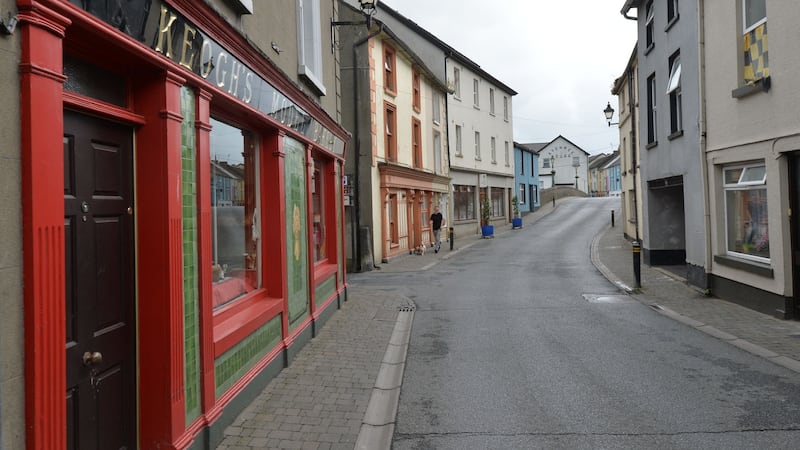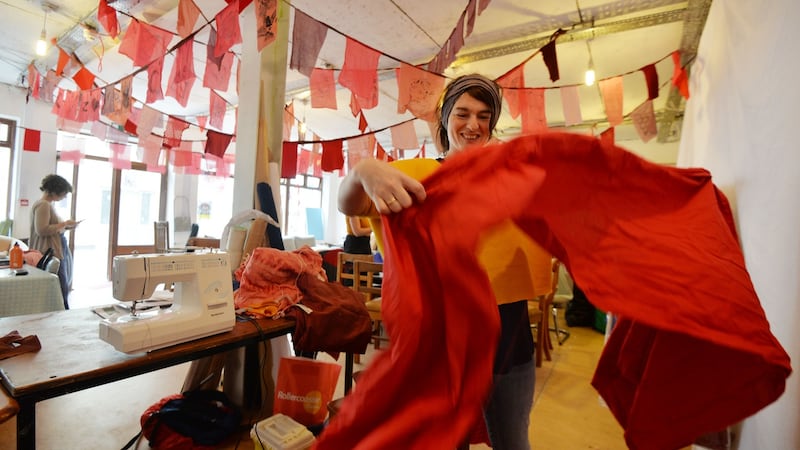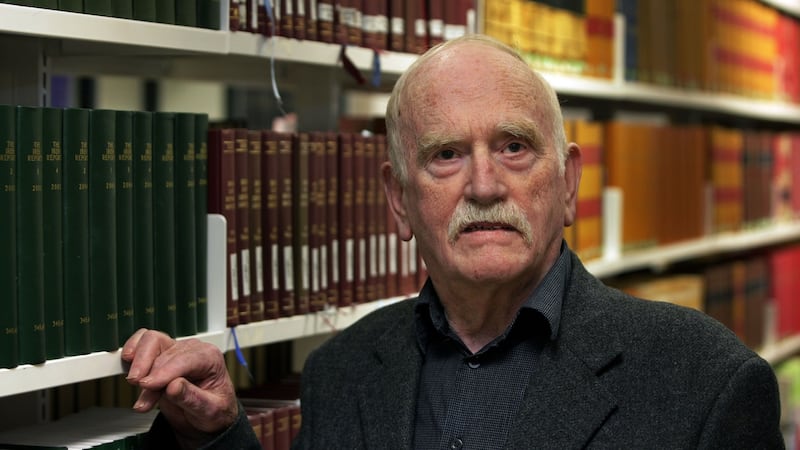We’re chatting out the back of the eclectic, characterful cafe, Fennelly’s of Callan, on a sunny afternoon when a man pops his head out the door and gestures to Medb Lambert. “Oh, that’s my father, he’s dropping off my rickshaw. Hang on and I’ll help him unload it.” Like you do. Lambert, adapter and designer on The Big Chapel X, an ambitious street production about to hit town, bought the rickshaw on DoneDeal. It’s the real McCoy, and entirely fortuitously, it’s red and blue, symbolic colours for the performance it’s in.
That performance will be on the streets and in the buildings of Callan, Co Kilkenny, 20km south of Kilkenny city, telling a dark story steeped in the town’s old bones, and which was at the centre of Thomas Kilroy’s 1971 Booker-nominated novel.
We start our traipse around Callan up a hill – as does the true story, and this month’s performance – at the Mercy school. In 1872, the local parish priest, Fr Robert O’Keeffe, wanted to bring an order of French nuns from Beziers to start a progressive school for girls in the town. He didn’t get permission from the local bishop, and all hell broke out. It went beyond the issue of girls’ education, becoming a turf war, about the priest’s pride, the bishop’s control and Vatican power, and a territorial battle between state and church.
Director Donal Gallagher points out the house where O’Keeffe lived. “He was a firm believer in girls, understood the value of education, but he was also a bit arrogant. He fell foul of the bishop and it became a personal thing between them. But he drove on regardless.” He was berated by his own curate from the pulpit, later sued the curate and the bishop in civil court, and the cardinal stepped in. It “pitted civil law in direct conflict with canon law”. Civil law was the law of the crown, and the Protestant aristocracy. Rome was trying to consolidate power, and sell the idea of papal infallibility.
‘Repercussions across Europe’
The outfall of this row in the small town of Callan included a British parliament debate that almost brought down the government, twice, while the row was being thrashed about by the pope in Rome. “It was a case that had repercussions across Europe.”

In the meantime, the locals split between supporting the priest and the bishop; this story involves class and rural-urban divides as well as church-state, with farmers and poorer people supporting the priest, set against business and wealth. The church was put into interdict. “The bishop basically tells anyone who goes to the church” – Gallagher points across town at the steeple of the church, also part of the promenade performance – “is the spawn of Satan, and that he’s no longer a proper priest. That’s a big thing to be telling people in 1870s’ Ireland. So half the town went up to Mass in his church – he’s ringing the bell there – and the other half went to the Friary,” he points left, “where the bishop’s man set up an alternative church.”
Intriguingly, the “alternative” was the Catholic establishment, which the priest called the Schismatics (“A clever move on O’Keeffe’s part, to make it sound like they were the ones causing the split.”)
“Every Sunday there are riots on the street and they’re kicking the shit out of each other over this. Someone is killed. Eventually, his support dwindled and one day a mob marches on the church to tear the roof off and get rid of the priest. They literally pulled the tongue from the bell.”
The amazing tale has figured in academia – most recently in historian Colin Barr’s book The European Culture Wars in Ireland: The Callan Schools Affair, 1868-81, which “tells the true history of the schism . . . we love him” says line-producer Orlaith Treacy.
It also figured in fiction, in Kilroy’s The Big Chapel (where the priest is Fr Lannigan), a dark and subtle dissection of religious violence; Kilroy had one eye on the North in writing it, and it is painfully relevant today. “Our eyes,” observes Gallagher, “on the other hand, are on the broader global picture of binary division: black/white, rich/poor, Christian/Muslim, pro/anti-Trump or Brexit, and the dwindling of any sort of reasoned debate.”
Very supportive
Gallagher, Lambert and writer John Morton adapted the novel for Asylum Productions' site-specific performance. Kilroy has been very supportive of it. "We had two ideas we felt might be contentious," says Gallagher. "How exactly do you say 'So Tom, we want to take your award-winning, Booker prize-nominated novel, re-set it in a parallel universe, and give it a happy ending'? When we met, before we had a chance to broach it, Tom's first words were "This is your adaptation, so you must feel free to do what you need to do. But you might want to think about taking it out of the historical context. And you should probably take a look at the ending. It's a bit grim."

While it’s an adaptation (note the added X), and the spirit, characters, story and themes of Kilroy’s work are crucial, this is aiming at “something more visceral, emotive and participatory”. Gallagher stresses “we’re not doing a period piece. Instead, we’re setting our adaptation in an alternate reality that owes almost as much to Margaret Atwood’s Handmaid’s Tale, or Game of Thrones as it does to the novel. It’s four years condensed into a two-hour real-time journey, that has to follow a linear geographical path, and be both theatre and street spectacle. That calls for a lot of liberties!”
They have made Nina Scully (played by Grace Collender), the teenage daughter of fictional Master Scully, a focus for the story. “In the novel, she is a victim of circumstances. Our Nina is heavily influenced by Emma Gonzales, Greta Thunberg, Malala Yousafzai, Lyra McKee . . . female teenagers, all ‘outsiders’ in their own way, each speaking a clear and simple truth to power.”
Asylum Productions doing The Big Chapel X in its homeplace, as part Kilkenny Arts Festival (with financial support from the Abbey theatre), has been long in gestation. It is owned by the town and of the town, with the team pulled from among its cultural wealth. KCAT (Kilkenny Collective for Arts Talent) is helping with facilities, and its Equinox Theatre Company are in the cast. UCD Architecture, Fennelly’s cafe, Kilkenny LEADER Partnership, the town of Callan and many of its businesses and community groups are all wrapped up in it with goodwill and support.
It is part of a wider project, exploring Kilroy’s work: Etaoin Holahan of Fennelly’s has made a year-long podcast series exploring the novel, with one episode per chapter.
An unused shop space on Lower Bridge Street has become an open window on the show and a making-space, full of fabric swatches, bunting, drawings and sewing machines, with couches and tea for when people drop by.
As of last weekend, the cast numbered 97; with crew, construction, costumes, stewards, traffic management, technicians, interns and core creatives, there are more than 150 people involved. Workshops started months ago, and the production has evolved: the Riot Squad of about 20 speaking roles, the Voice Squad 40-strong community choir and the Hit Squad of local volunteer crew. Lambert says: “There’s no differentiation between community cast and professionals.” Gallagher says “this works both ways – the professional cast bring skills and training, but the community cast brings a level of passion, investment and commitment that can’t be taught, but can be infectious!” Lambert: “Professional actors and theatre makers are supporting and facilitating the community cast. We live here. The engagement is real. We don’t leave.”
Community engagement
Watching it in action is seeing an inspiring model for community engagement as well as theatre creation.
Gallagher says it’s “as much about participation as observation – and actual participation in the creative process, not just the performance, but forming the story. There will be almost as many people involved as watching it. We say, you can spend €20 to see it, or you can be in it for free.”
The promenade will move from inside today’s girls’ secondary school, down Bridge Street to the cross, onto Mill Street and into the Friary, later back out to the cross, up Green Street and to the old co-op.

In their story, Red represents the rebel priest and his followers, and Blue represents orthodoxy. Designer Lambert collaborated with Morton and Gallagher to design the journey and the experience as much as the visuals. She tried to “listen to spaces we’ll be moving through, asking the audience to see it both as it is, and in ‘this theatrical world’, a kind of double vision, sleight-of-hand. There’s a weight to the process, and a fragility in the engagement with it. I get to be playful and serious, heavy and light. Red and Blue is the heavy-handed end. I want us to think about this over-simplification of everything today (and I’m drawing from Keanu Reeve’s character’s choice in The Matrix – Red Pill or Blue Pill?)”
Kilkenny Arts Festival’s new director Olga Barry has been invested in Big Chapel X from the start. “It’s a very exciting departure for the festival. Over the years it has stretched out from the city, into Inistioge, Thomastown and Dunmore, but never has a whole town been taken over as the set itself. It’s a real joy for us to embrace the working method of Donal, Medb and Asylum. The sense of ownership, with the large numbers in the community cast and choir, is incredibly special and is a real highlight of this year’s festival.
“It also gives us an opportunity to celebrate Thomas Kilroy and his work in a real, living way. The adaptation can see the ‘story’ in the big picture, while also refocusing the experience in the personal. Thomas has been unending in his generosity towards the project and events around the show. The response from people booking tickets has been special, and shows we all feel connected to our own history and the arts can move that connection into a more visceral experience.”
For Gallagher, “we’ve basically asked 100 people to come out and play. And also to use a story of historic division to bring people together – a secular alternative ‘church’. (We ignore our history at our peril.)”
The Big Chapel X is in Callan, August 11th-17th. Kilkennyarts.ie. Thebigchapel.com includes the podcast. Among associated events, Thomas Kilroy talks with Asylum (Aug 13th) and reads from his memoir Over the Backyard Wall (Lilliput Press) on Aug 11th













